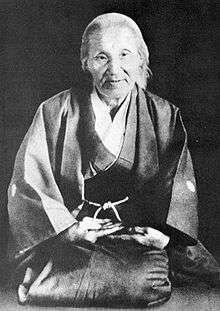Nao Deguchi
Nao Deguchi (出口 なお) (January 22, 1837 – November 16, 1918) founded the religion Oomoto-kyo after being possessed by a spirit called Ushitora no Konjin. Even though she was illiterate, she wrote 200,000 pages of prophesies while possessed.
Nao Deguchi | |
|---|---|
出口 なお | |
 | |
| Born | January 22, 1837 Fukuchiyama |
| Died | November 6, 1918 |
Biography
Deguchi was born in Fukuchiyama, Tanba province (present day Kyoto prefecture) on January 22, 1837. She was the third child and the first daughter. She was born in the middle of a famine, so her parents considered abandoning her, but chose not to after Deguchi's grandmother scolded them. Her father, Gorosaburo Kirimura, died of cholera when she was 9, leaving Deguchi to work to support the family.[1]
When she was 16 she was adopted into the Deguchi family. The Deguchis had no children, and adopted her so that she could marry their adopted son, a carpenter named Masagoro Deguchi, and continue the family name. They had 8 children, but because of Masagoro's alcoholism and financial mismanagement, the family lived in poverty. After falling off a house and breaking his pelvis, Masagoro died on March 1, 1887.[2]
In 1892, Deguchi was possessed by a spirit called Ushitora no Konjin, who prophesied that the world would soon end and that a savior would come and create heaven on earth.[3] Though she was illiterate, whenever the spirit would speak to her, she would write down the prophesies through automatic writing. She wrote over 200,000 pages of prophesies.[4] She called these writings Fudesaki (御筆先). She initially acted as a branch of Konkōkyō, then broke off and founded her own religion.[5]
Deguchi met Onisaburo Deguchi, in 1899, and he married her daughter, Sumiko, in 1900. He organized her writings into Oomoto-kyo's scripture, and codified the religion. Together, they started the Dai Nihon Shūseikai. In 1913 its named changed to the Taihonkyō, and in 1916 the name changed again to the Kōdō Ōmoto. Despite their work together, they sometimes had different interpretations of the writings that Deguchi had created. Deguchi died on November 6, 1918.
Selected bibliography
- Deguchi, Nao (1979). Ōmoto shin'yu. Heibonsha.
Further reading
- Groszos Ooms, Emily (2010). Women and Millenarian Protest in Meiji Japan: Deguchi Nao and Omotokyo. Cornell University. ISBN 9780939657612.
- Miyata, Mami (1988). Deguchi Nao: modernization and new religions (Master of Arts thesis).
- Oishi, Sakae (1982). Nao Deguchi : a biography of the foundress of Oomoto. Kameoka, Japan: Oomoto Foundation.
References
- Irimame no hana. Deguchi, Yasuaki, 1930-2002., 出口, 和明, 1930-2002. 八幡書店. 1995. ISBN 4893501801. OCLC 674760491.CS1 maint: others (link)
- "Nao Deguchi A Biography of the Foundress of Oomoto". www.oomoto.or.jp. Retrieved 2018-11-28.
- "Ōmoto | Japanese religion". Encyclopedia Britannica. Retrieved 2018-11-28.
- "Weaving her way back to harmony with the gods | The Japan Times". The Japan Times. Retrieved 2018-11-28.
- "Encyclopedia of Shinto - Home : Personalities : Deguchi Nao". eos.kokugakuin.ac.jp (in Japanese). Retrieved 2018-11-28.